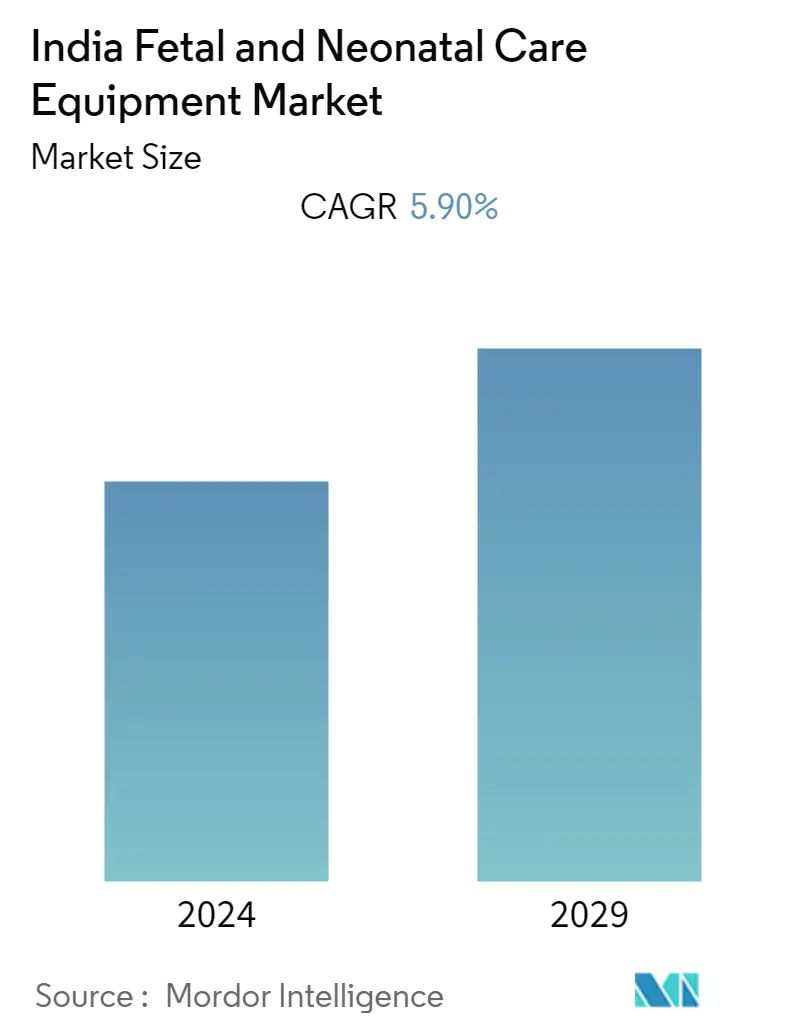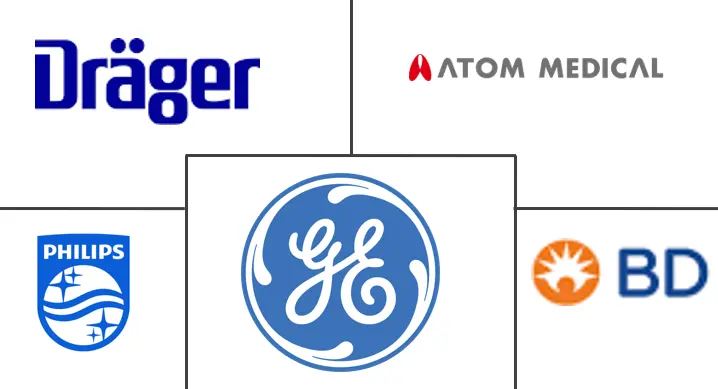Market Size of India Fetal and Neonatal Care Equipment Industry

| Study Period | 2019 - 2029 |
| Base Year For Estimation | 2023 |
| Forecast Data Period | 2024 - 2029 |
| Historical Data Period | 2019 - 2022 |
| CAGR | 5.90 % |
| Market Concentration | Medium |
Major Players
*Disclaimer: Major Players sorted in no particular order |
India Neonatal and Prenatal Devices Market Analysis
India's neonatal and prenatal devices market is expected to register a CAGR of 5.9% over the forecast period.
The COVID-19 pandemic has significantly impacted the Indian neonatal and prenatal devices market. As per the study published by PubMed Central in March 2022, movement restrictions brought on by the lockdown, the lack of public transit, and the concern of contracting Women who have COVID-19 were prevented from using maternal healthcare services. Moreover, as per the study published by PubMed in January 2021, the reduced coverage for all interventions related to mother and child health. The total number of institutional deliveries decreased by 2.26%. The worst-affected services, with a 22.91% reduction, were those for antenatal care. Thus, the COVID-19 pandemic severely affected the market; however, as the pandemic has subsided, the studied market is expected to have stable growth over the forecast period.
The major factors for the growth of the India fetal and neonatal care devices market are increased preterm birth rates, greater public awareness of the importance of prenatal and neonatal care, and government measures to improve care for infants.
Premature babies are born before the mother reaches the gestation period of 37 weeks. Depending on how premature the baby is, certain organs can be underdeveloped, such as the digestive tract, lungs, immune system, and even skin, in certain cases, where the demand for incubators for their survival is inevitable. As per an article published by Times of India in July 2022, the number of premature babies in the region is increasing due to the increasing prevalence of diabetes and obesity among women, along with the rise in multiple births due to fertility treatments. Moreover, as per the United Nations International Children's Emergency Fund (UNICEF) data updated in July 2021, nearly 3.5 million babies in India are born too early, 1.7 million babies are born with congenital disabilities, and one million newborns are discharged each year from Special Newborn Care Units (SNCUs). These newborns remain at high risk of death, stunting, and developmental delay, which will add to the growth of the studied market.
Moreover, UNICEFs focus on equitable reduction of neonatal deaths is in line with the Government of India's "India Newborn Action Plan," for which UNICEF is a key partner. The Action Plan aims to significantly reduce preventable newborn deaths and stillbirths and reduce neonatal mortality and stillbirth rate to a 'single digit' by 2030. As thematic technical lead for facility-based newborn care, UNICEF has been instrumental in the scale-up of SNCUs across India and creating one of the biggest real-time online databases for sick newborns globally. UNICEF has also been assigned the role of lead partner in 39 out of 115 aspirational districts in India. With poor indicators across social sectors, these aspirational districts have been identified by NITI Aayog in coordination with line ministries for convergent action.
Thus, all these factors drive the demand for prenatal and neonatal devices across India. However, low birth rates in developed countries, lack of awareness, and economic constraints in many areas are the major factors hindering growth in India's neonatal and prenatal devices.
India Neonatal and Prenatal Devices Industry Segmentation
As per the scope of this report, fetal monitoring devices are vital tools routinely used in gynecology and obstetrics interventions to examine fetal health during labor and delivery. Neonatal devices are extensively used in Neonatal Intensive Care Units (NICUs), where complex machines and monitoring devices are designed for the unique needs of tiny babies. India's Fetal and Neonatal Care Equipment Market is segmented by Product Type (Prenatal & Fetal Equipment (Fetal Dopplers, Fetal Monitors, Fetal Pulse Oximeter, and Other Prenatal and Fetal Equipment) and Neonatal Care Equipment (Incubators, Neonatal Monitoring Devices, Phototherapy Equipment, Respiratory Assistance, and Monitoring Devices, and Other Neonatal Care Equipment)). The report offers the value (in USD million) for the above segments.
| By Product Type | |||||||
| |||||||
|
India Fetal and Neonatal Care Equipment Market Size Summary
The neonatal and prenatal devices market in India is poised for steady growth, driven by increasing preterm birth rates and heightened public awareness of the importance of maternal and infant care. The market experienced significant disruptions due to the COVID-19 pandemic, which led to reduced access to maternal healthcare services and a decline in institutional deliveries. However, as the pandemic's impact wanes, the market is expected to recover and expand. Government initiatives, such as the India Newborn Action Plan, and partnerships with organizations like UNICEF are pivotal in reducing neonatal mortality and improving healthcare infrastructure. These efforts are complemented by the rising prevalence of conditions like diabetes and obesity among expectant mothers, contributing to the demand for advanced neonatal care devices.
The market is characterized by a diverse range of devices, including neonatal incubators and respiratory monitoring systems, which are crucial for supporting premature infants and those with respiratory distress. The development of cost-effective alternatives, such as MiraCradle and Embrace Nest, is making these technologies more accessible across the country. The presence of both large and small players, such as GE Healthcare and Atom Medical Corporation, adds to the market's competitiveness. Collaborative efforts, like the partnership between InnAccel Technologies and C-CAMP, aim to enhance respiratory support for newborns in underserved regions. These dynamics, along with the increasing birth rate, are expected to drive robust growth in the neonatal and prenatal devices sector over the forecast period.
India Fetal and Neonatal Care Equipment Market Size - Table of Contents
-
1. MARKET DYNAMICS
-
1.1 Market Overview
-
1.2 Market Drivers
-
1.2.1 High Number of Preterm and Low-weight Births
-
1.2.2 Rise in Technological Advancement for Infant and Maternal Care Products
-
1.2.3 Increased Awareness for Prenatal and Neonatal Care
-
-
1.3 Market Restraints
-
1.3.1 Stringent Regulatory Policies for New Device Approvals
-
1.3.2 High Prices of Advanced Neonatal Care Equipment
-
-
1.4 Porter's Five Force Analysis
-
1.4.1 Threat of New Entrants
-
1.4.2 Bargaining Power of Buyers/Consumers
-
1.4.3 Bargaining Power of Suppliers
-
1.4.4 Threat of Substitute Products
-
1.4.5 Intensity of Competitive Rivalry
-
-
-
2. MARKET SEGMENTATION (Market Size by Value - USD million)
-
2.1 By Product Type
-
2.1.1 Prenatal & Fetal Equipment
-
2.1.1.1 Fetal Dopplers
-
2.1.1.2 Fetal Monitors
-
2.1.1.3 Fetal Pulse Oximeters
-
2.1.1.4 Other Prenatal and Fetal Equipment
-
-
2.1.2 Neonatal Care Equipment
-
2.1.2.1 Incubators
-
2.1.2.2 Neonatal Monitoring Devices
-
2.1.2.3 Phototherapy Equipment
-
2.1.2.4 Respiratory Assistance and Monitoring Devices
-
2.1.2.5 Other Neonatal Care Equipment
-
-
-
India Fetal and Neonatal Care Equipment Market Size FAQs
What is the current India Fetal and Neonatal Care Equipment Market size?
The India Fetal and Neonatal Care Equipment Market is projected to register a CAGR of 5.90% during the forecast period (2024-2029)
Who are the key players in India Fetal and Neonatal Care Equipment Market?
Atom Medical Corporation, Becton, Dickinson and Company, Dragerwerk AG & Co. KGaA, GE Healthcare and Koninklijke Philips NV are the major companies operating in the India Fetal and Neonatal Care Equipment Market.

